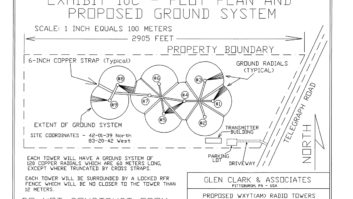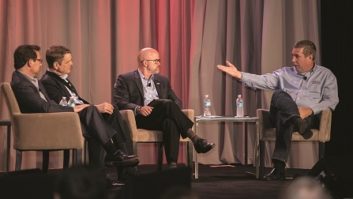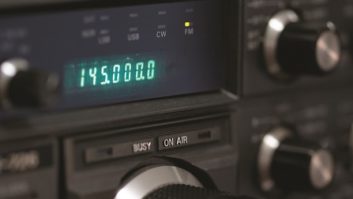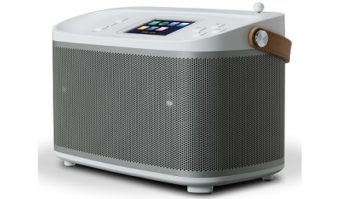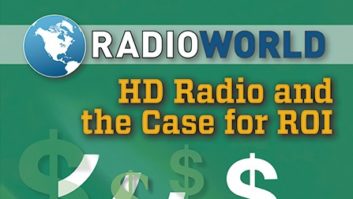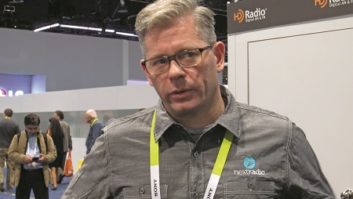LAS VEGAS — To demonstrate that receivers are becoming more readily available from mainstream automakers, iBiquity Digital showed in-dash HD Radios in a 2011 Ford truck and Volvo crossover vehicle in a prominent space at the NAB Show.

Kelly Jarvis of iBiquity demonstrates an HD Radio receiver in a 2011 Ford 250 Super Duty pickup truck to Nick Wymant of RFS. Photo © NAB Meanwhile digital AM is getting more attention. Some transmitters at the convention incorporated an iBiquity transmission configuration intended to benefit high-power AMs airing talk or lightly processed music formats. The technology developer also is exploring a way for HD Radio receivers to display souped-up data broadcast via analog AM signals, similar to what is now available from stations airing digital FM or FM RDS.
The HD Radio FM digital power increase was big news at the show. The FCC order approving the increase had just been published in the Federal Register, and the increase took effect not long after the convention. FM digital stations that want to increase digital power by 6 dB now can do so without applying for special temporary authority.
Several requests for the full commission to review the Media Bureau order were filed. But although the commission potentially could tweak the increase, it is unlikely rescind it, sources believe; the FCC repeatedly has said it wants to help foster radio’s digital transition.
Exhibitors also discussed the concept of asymmetrical sidebands, a way to help a station achieve the power boost without harming an adjacent analog signal. Once stations begin using this approach experimentally and become experienced with it, transmission manufacturers expect the FCC eventually will approve asymmetrical sidebands for general use, much as it did multicasting and separate antennas.
Highlights of digital radio news from the show:
Modified MA1 Benefits AMs
IBiquity Digital unveiled an optional AM IBOC transmission configuration that is meant for digital AM stations that air talk, have low audio program density or are not planning to send discrete data.
Some high-powered AMs had said that some wideband receivers made before 2003 produced audible interference to the host station’s analog signal from the digital secondary and tertiary sidebands. The new transmission configuration, called “Modified MA1,” is meant to address this.
In the new low bandwidth mode, “We turned off the secondary and tertiary carriers. We raised the level of the PIDS carriers, the station information carriers, to the same level as the primary carriers,” said Jeff Detweiler, director of iBiquity Digital’s broadcast business development. “All of the host interference that used to occur goes away.”

KUVO’s Mike Pappas conducts a DTS-Neural surround sound demo in a Lincoln in the DaySequerra booth. DTS-Neural’s Mark Seigle says the surround technology was used in some 650 stations in 2009 and the company hopes that will approach 700 soon. Photo by Jim Peck The new exciter configuration reduces the digital bandwidth and increases the analog bandwidth of the AM IBOC hybrid signal.
There’s an improvement in signal-to-noise ratio of 6 to 10 dB on all analog radios with the new configuration, according to iBiquity.
It previously had recommended that stations limit analog audio bandwidth to 5 or 8 kHz; in the new configuration, stations can transmit using the full 10 kHz.
Codec improvements at low bit rates now allow for good mono, “parametric stereo” or stereo audio in a single 20 kbps audio stream.
The normal MA1 configuration uses 36 kbps for audio. Near the tower, a listener hears stereo; father away the signal shifts to mono digital, then to analog. Those noticeable transitions could be annoying to the listener. With the Modified MA1 configuration, the digital AM audio is either mono, “parametric stereo” or stereo all the way until the signal blends to analog, providing a more consistent user experience, Detweiler said.
The changes are contained in a software load that iBiquity released to transmission manufacturers in December; the changes were reflected in transmitter models on display at the show.
AM Data Display Study Underway
Meanwhile, iBiquity is trying to develop a low-cost method of transmitting digital data with an analog AM signal, so that future HD Radio receivers can have snazzy AM data displays — similar to what is now available on FM HD and RDS receivers — even if the originating AM station is analog-only.
National Radio Systems Committee Chairman Milford Smith, the vice president of radio engineering for Greater Media, said the idea is akin to RDS for analog AM but without requiring the broadcaster to initiate HD Radio transmission.
“The station’s audio is analog but the receiver would recognize the digital data and display it,” said Smith.
Details such as the ideal bit rate and the content to be displayed, such as call letters, are still being worked out on this AM analog low rate data service. The project is funded by the NAB FASTROAD technology development program.
Detweiler said during a convention session that the company has studied six design options and is narrowing in on two for further study, looking to minimizing station costs as well as evaluating IBOC compatibility and the impact to the host analog signal.
IBiquity hopes to have a feasibility report on the concept ready by the fall NAB Radio Show.
Struble Bullish on Receiver Sales
As the economy begins to turn around, iBiquity Digital President/CEO Bob Struble is realistic about the time it will take time for radio stations once again to devote serious money and other resources to digital conversions. The technology executive says stations continue to convert to IBOC technology but admittedly not at the pace they had been before the recession took hold.
“I talk to many industry leaders and get a good sense, generally, that things are picking up. But you also have to keep in mind that things got really, really bad, so there’s a long way to get back,” said Struble. Even though business is improving, he said, many radio groups are struggling with debt.
“For the last 18 months, capital spending in radio has dried up because of the economic realities of the business. We don’t forecast that improving much in 2010. I don’t need it to go up a ton; I just need it to stop going down. And I’ve got some confidence that we will see that.”
What iBiquity is hoping will bring broadcasters back or cause them to take a fresh look is twofold: HD Radio’s momentum in the consumer space and the increase in data applications, which is helping some stations to make money with IBOC.
IBiquity tried something different for NAB this year; it used two exhibit spaces and displayed factory built-in HD Radios in a Ford 2011 SuperDuty pick-up truck and a Volvo XC60. The vehicles were in a prominent space between the North and Central Halls. Attendees could sit in the vehicles and listen to HD Radio.
“NAB wanted to do something special in that space,” said Struble. He quoted a Detroit phrase: “Hardware sells hardware.”
“If people see something and touch it, they’re more likely to buy,” he said. The company believes showing radios in mainstream vehicles demonstrates its momentum in the OEM sector.
With more HD Radio receivers in cars and the advent of digital portables, sales to date have reached more than 2.5 million units, according to Struble. More than halfway through iBiquity’s fiscal year, he predicts, “We are comfortably going to do another two times what we did last year” in receiver sales.
While not claiming victory or critical mass yet, “2.5 million is certainly different than what we were talking about two years ago,” when receiver sales stood at 200,000, he said.
With the advent of more data applications that use HD Radio technology — such as multicasting, traffic services and iTunes Tagging — “plenty” of stations are making money and getting a return on IBOC investment, he said. “That becomes easier the more receivers that are out there.”
Building on song tagging, soon the market will see album art and other graphics on the screens of their HD Radio receivers. Tagging will expand beyond music to advertising, said Struble.
For example, if you tag an ad, it will send you to a website where you can redeem a coupon. Those actions give the station, and the advertiser, direct response, accountability and reporting information. “We think that’s going to be increasingly important as other media services are able to provide that,” according to Struble.
Yet, despite the optimism, radio is just beginning to recover from a recession in which stations laid off people and reduced budgets severely.
Radio World asked about rumors heard at the show that some stations, faced with budget cuts, may let AM HD Radio operations stay off the air when there’s a problem rather than repairing them right away. Struble said he believes this does happen but that it is not a widespread situation.
“If you had a guy who was responsible for re-booting the exciter, that guy isn’t there anymore; and now it’s on someone else’s list, and it may take awhile. I think the lack of personnel and the impact of layoffs is real.”
Regarding the FM digital power boost, Struble said he’d heard anecdotally about newly digital stations going on the air with IBOC at the elevated power level. He also reiterated his past statements that radio’s transition will be gradual.

This Active Radio emergency alert in iBiquity’s booth was sent using software from SpectraRep. Photo by Leslie Stimson ‘Active Radio’ Emergency Alerts Shown
IBiquity demonstrated the “Active Radio” emergency alerting concept. An HD Radio receiver with this technology can detect alerts even when turned off.
The company generated the alert using software developed by SpectraRep. Both audio and data messages are supported.
Shortly after the show, the concept was tested on WAMU(FM) in Washington. The alert was transmitted using the station’s HD Radio signal. Nautel, SpectraRep and Sage Alerting Systems provided equipment.
“It’s especially critical to alert those with sensory disabilities, now possible due to the new accessible digital radio services NPR has been developing,” stated Mike Starling, vice president and chief technical officer of NPR.
The HD Radio Emergency Alert broadcast protocol is compliant with the Common Alerting Protocol message definition adopted by FEMA and other emergency organizations, according to the companies involved in the demo. The HD Radio system will allow federal, state and tribal emergency agencies to notify the public of presidential directives, national security alerts, AMBER Alerts or weather-related events.
Stations can use the audio and data channels of their HD Radio signal to send multilingual announcements, text alerts and image data to alert-enabled receivers.
HD2 as ‘Training Wheels’?
Numerous stations are using their multicast channels to make money, says iBiquity.
Moderating a session called “HD Radio Digital Marketing: Cashing In on All Your Content,” Rick Greenhut, the director of U.S. broadcast sales for iBiquity, highlighted six.
In general, he said, HD2 and HD3 channels have “become the training wheels for some advertisers” who can’t afford to be on the main channel.
Station representatives prepared videos in which they described how they’re integrating their on-air, website, streaming, HD Radio and print/billboard presences into one brand image.
Radio You Boston is an indie rock station that features local bands, owned by Greater Media and airing on a multicast of WBOS(FM). Its target demo is adults 18–24. Greenhut said the station sought to tie in its HD2 spots with Web banner ads and branding.

You didn’t know HD Radio could be sexy, did you? Condom maker Lifestyles is an advertiser on Greater Media HD2 station Radio You Boston, which gives away this branded product at events. Photo by John Staley © NAB The Connecticut School of Broadcasting and condom maker Lifestyles bought advertising schedules on Radio You Boston. Lifestyles gave thousands of condoms with branded station packaging to the HD2 station to hand out at events.
The HD3 channel of WAMU(FM) in Washington, Bluegrass Country, is nearing its third anniversary. In a recent fundraiser, approximately 400 members donated a total of $40,000.
A spokesman for Emmis station KSHE2 in St. Louis, an HD2 channel, said in a video to attendees, “We want to get people back from satellite and iPods. We want people to think of HD Radio as newer than the Internet.” The multicast channel has top-of-the-hour ads, including Harley Davidson and a Bar-B-Q restaurant.
Graffiti Radio in Wilmington, Del., run by Delmarva Broadcasting, is targeting students in high school and college, when buying habits typically are being formed.
The HD2 channel of KNDE(FM), College Station, Texas, programs “Rock Candy” on its HD2 and uses its HD3 station for its own product. “Play & Replay” airs original coach interviews and other station-produced sports material.
A station representative, speaking to attendees via a video, said they have to promote the multicast station with limited resources and without hurting their main channel. The station targets college students and had an apartment complex that’s an advertiser sponsor a mouse pad featuring the “un-academic” calendar, which highlights holidays.
Utah Public Radio in Logan, Utah, features “Fusion HD3.” It has new underwriters that only want to buy on the HD3 channel, according to Greenhut. Students run this college station.
And finally the Pittsburgh Penguins believe they have the first HD Radio station devoted to a professional sports team. The HD2 slogan is “All Penguin hockey, all the time.”
BIA/Kelsey predicts U.S. radio organizations will bring in $500 million revenue in 2010 from digital sources including the Web, mobile apps, streaming and HD Radio, Greenhut noted. The stations discussed in the session provide incentives to sales people to sell the multicast channels. “They place a dollar value on HD Radio spots, [they ‘re] not just throwing them in.”

